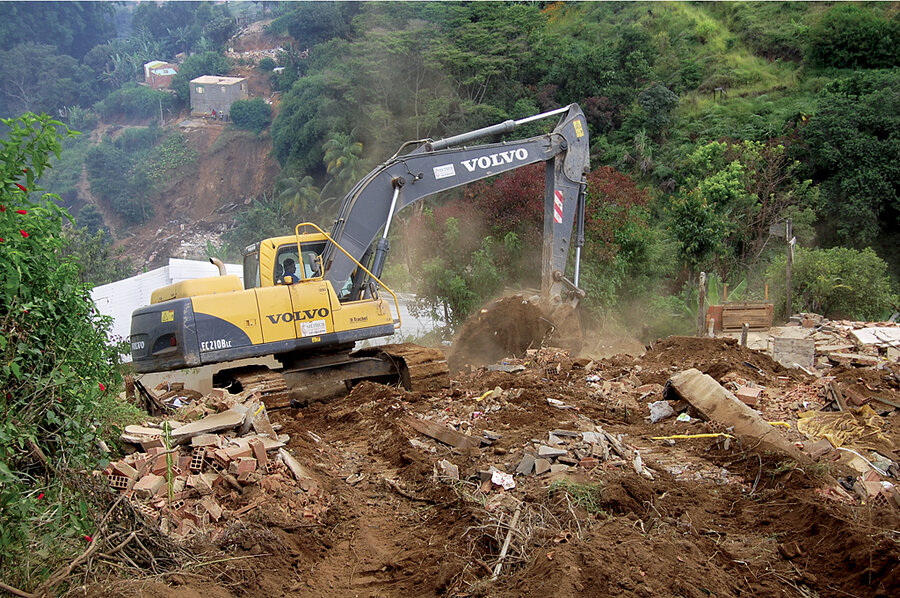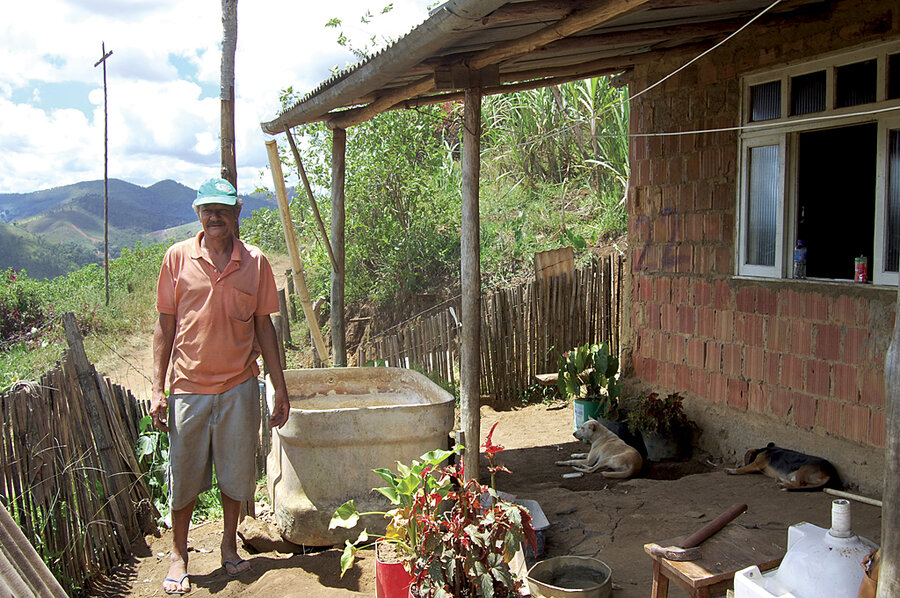Brazil's floods force urban planning rethink
Loading...
| Nova Friburgo, Brazil
Nilson Gomes de Santa patiently watches a demolition team circle his home in the interior of Rio de Janeiro State. Workers are about to tear down the bricks this mason laid with his own hands 25 years ago, and he's fine with that.
Other than his three dogs and a tank of cooking gas, there's little left in his bus-sized home, which stands alone on a dirt-caked hill where a neighborhood bustled just a month ago. Then a month's worth of rain fell in one day, sending mudslides flowing down this hillside favela (shantytown). After seeing homes swept away and neighbors buried, Mr. Gomes de Santa resigned himself to eviction.
As he speaks, workers pack his possessions – a television, a table, toolboxes – that will be put in storage. An excavator demolishes homes nearby.
"It's difficult to leave," says Gomes de Santa, who lived with his wife and three grandchildren here in Alto da Floresta. "I looked to the front," he says, pointing to where nine neighbors' bodies were buried in a mudslide, "and said, 'I'm not going to stay here.' "
Past attempts in Brazil to enforce building codes in favelas have not gone so smoothly. But since the January floods killed at least 900 people and left another 400 missing, the government and the public are coming to terms with the importance of urban planning. Residents of the região serrana ("mountainous region") a few hours west of Rio de Janeiro were left reeling. Alto da Floresta residents described being awakened by the sound of screams and rushing water as their hillside turned into a river of mud. Cars and bodies floated down streets.
Brazil-wide, stricter housing regulations enforced
For a country accustomed to annual flooding, the deadliest mudslides on record provided impetus for the government to start enforcing stricter housing regulations and for low-income favela residents to accept relocation. The city of Rio de Janeiro has already torn down seven favela buildings deemed at "high risk," and São Paulo State has begun the demolition of some 230 homes where floods occurred. Most demolitions are happening where the floods hit hardest, in the areas around Gomes de Santa's home.
His neighborhood was among the first to go when demolitions began Jan. 24 after authorities condemned 250 houses here in Nova Friburgo and 1,500 in nearby Teresópolis. Officials cut neighborhood utilities and threatened forced evictions – though unlike past eviction attempts, this time many people have willingly relocated.
"Housing in 'areas of risk' is the rule in Brazil rather than the exception," President Dilma Rousseff, inaugurated less than two weeks before the flooding, said after flying over the stricken areas. "When there aren't housing policies, where are people who earn no more than twice the minimum wage going to live?"
Government offers $300 a month to evacuees
The answer to that question is coming in the form of government subsidies. Rio State is allotting about $300 monthly for up to a year to evictees. Ronaldo da Silva Leandro is using it to rent a room here in Alto da Floresta, after the Civil Defense agency condemned his house because it's too close to the one in front of it and could create a domino effect in future floods.
"I don't accept it, but they said they will demolish the house," the bricklayer said recently, removing his home's glass windows before it was demolished the following day. While the government says it is building 3,000 new homes for those relocated, Mr. da Silva Leandro and Gomes de Santa both say they're not counting on it. Still, Gomes de Santa's wife says she is ready to use the subsidy to rent a new home on safer land for the time being. "It's just like a cemetery there," says Edna Martins, surrounded by her grandchildren – though she adds that she would have resisted the Civil Defense's orders before the tragedy.
Indeed, favela residents have long opposed relocation plans, and government officials have long chosen to ignore the problem in exchange for voter support from favela residents, says Flavia Bartoly, who spent six years as an engineer assessing high-risk areas with the Civil Defense of Teresópolis. She recalls the difficulty of coaxing residents to leave their homes despite promised rent assistance, as with one woman who couldn't even balance a cup on her table because her house was at such a steep pitch.
The woman told her she did not want to disorient her visually impaired son and, moreover, "I've already lived here a long time."
Planting trees where favelas once stood
But should authorities have pushed harder for evictions? In the political blame game that followed the floods, national and state authorities accused municipalities of allowing citizens to build in insecure areas, while the federal government itself came under scrutiny for having recently slashed its natural-disaster budget. Many favela residents themselves were blamed for refusing past eviction attempts.
The mayor of Rio de Janeiro, which is preparing to host the 2014 World Cup and 2016 Olympics, announced that hazardous settlements would henceforth be more difficult to construct by emphasizing protection of city forests – a retreat from interpreting Brazil's Constitution with a generous view of squatters' rights. Governments say they will reforest these areas to prevent evictees from moving back.
Julio Wasserman, a professor at Rio's Federal Fluminense University and coordinator of its environment and sustainable development network, sees a shift in thinking among favela residents now willing to accept relocation. But the issue may yet turn political, he says, and evictees may attempt to return if proposed new housing units don't come to fruition when the rent assistance funds run out.
"The people forget," says Professor Wasserman, "and as they forget, it's going to be a lot more difficult."






